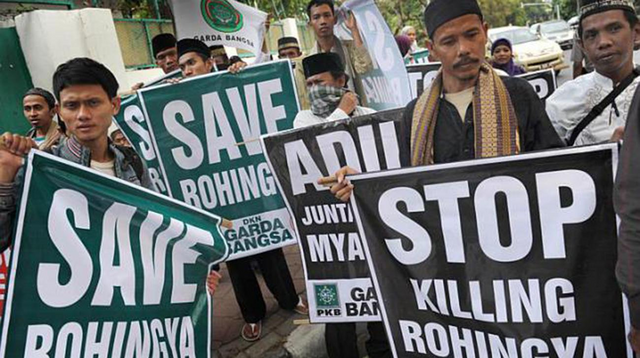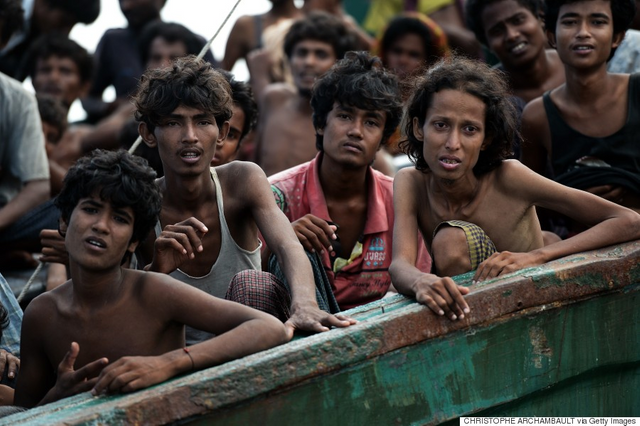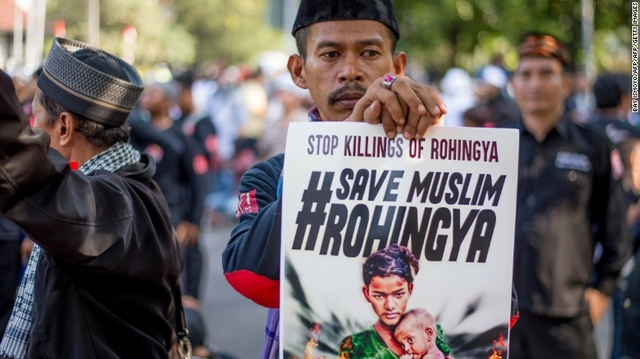Everything you want to know about "Rohingya issue" #1 - Who are the Rohingya?
Hello Steemit Friends,
Today I will be writing about one of the hot topics ie about "Rohingya issue"
Who are the Rohingya?

source
The Rohingya individuals; verifiably likewise named Arakanese Indians are stateless Indo-Aryan individuals from Rakhine State, Myanmar. There were an expected 1 million Rohingya living in Myanmar before the 2016– 17 emergencies. The larger parts are Muslim while minorities are Hindu. Portrayed by the United Nations in 2013 as a standout amongst the most oppressed minorities on the planet, the Rohingya populaces are denied citizenship under the 1982 Myanmar nationality law. As per Human Rights Watch, the 1982 laws "adequately deny to the Rohingya the likelihood of gaining a nationality. Regardless of having the capacity to follow Rohingya history to the eighth century, Myanmar law does not perceive the ethnic minority as one of the eight "national races". They are likewise limited from flexibility of development, state instruction and common administration employments. What number of have been murdered, harmed or compelled to escape? Assessments of the loss of life differ: the
Myanmar government asserts around 400 individuals have been executed up until this point; however, others say the number is considerably higher.

source
The UN assessed on 7 September that 1,000 had been murdered. Bangladesh's remote pastor, AH Mahmood Ali, said informal sources put the loss of life at around 3,000. More than 310,000 individuals had fled to Bangladesh by 11 September. The individuals who have influenced it to the fringe to have strolled for a considerable length of time, covering up in wildernesses and intersection mountains and streams. Many are wiped out and some have slug wounds. Help offices have cautioned of a developing philanthropic emergency in overstretched outskirt camps, where water, sustenance proportions and medicinal supplies are coming up short on stock. Most exiles are presently living in set up camps, improvised settlements or shielding in have groups. Almost 50,000 are in new unconstrained settlements that have jumped up along the outskirt, where access to administrations is particularly constrained. There are likewise fears for Rohingya individuals caught in strife zones. On 4 September, the UN said its guide organizations had been obstructed from providing life-sparing supplies, for example, sustenance, water and drug to a huge number of regular people in northern Rakhine state. What's the foundation to the story? For a considerable length of time ethnic pressures have stewed in Rakhine state, with visit flare-ups of savagery. In October 2016 nine cops were executed by furnished men, accepted by authorities to be Muslims. In the midst of the resulting savagery, 87,000 Rohingya Muslims fled to Bangladesh and government troops extended their essence in Rakhine state. At the time, a senior UN official affirmed that the Myanmar government was looking to free the nation of its Muslim minority – an allegation that has been made more than once by human rights gatherings. The administration denies the charge. In August, Myanmar additionally expanded the quantity of troops in Rakhine, after seven Buddhists were discovered hacked to death. The development of troops incited notices of a new rush of brutality.
The latest viciousness is viewed as a noteworthy acceleration in light of the scale, as well as on account of the inclusion of the new Rohingya activist gathering, the Arakan Rohingya Salvation Army. It says the assaults on government powers were a demonstration of self-preservation.
Here is a short history of the Rohingya individuals.

source
8th Century: The Rohingya, a people of South Asian beginning, abided in an autonomous kingdom in Arakan, now known as Rakhine state in current Myanmar.
9th to 14th Century: The Rohingya came into contact with Islam through Arab merchants. Close ties were fashioned amongst Arakan and Bengal.
1784: The Burman King Bodawpaya vanquished Arakan and a huge number of exiles fled to Bengal.
1790: Hiram Cox, a British ambassador sent to help exiles, set up the town of Cox's Bazar in Bangladesh, where numerous Rohingya still live today.
1824 to 1942:Britain caught Burma—now known as Myanmar—and made it a territory of British India. Specialists were moved to Burma from different parts of British India for foundation ventures.
1942: Japan attacked Burma, pushing out the British. As the British withdrew, Burmese patriots assaulted Muslim people group who they thought had profited from British provincial run the show.
1945: Britain freed Burma from Japanese occupation with help of Burmese patriots drove by Aung San and Rohingya contenders. Rohingyas felt sold out as the British didn't satisfy a guarantee of self-governance for Arakan.
1948: Tensions expanded between the legislature of recently autonomous Burma and the Rohingya, a significant number of whom needed Arakan to join Muslim-larger part Pakistan. The legislature struck back by alienating the Rohingya, including evacuating Rohingya government workers.
1950: Some Rohingya opposed the administration, drove by furnished gatherings called Mujahids. The uprising slowly faded away.
1962: General Ne Win and his Burma Socialist Program Party seized control and took a hard line against the Rohingya.
1977: The junta started Operation Nagamin, or Dragon King, which they said was gone for screening the populace for nonnatives. More than 200,000 Rohingya fled to Bangladesh, in the midst of assertions of armed force manhandle. The armed force denied any wrongdoing.
1978: Bangladesh struck a U.N.- expedited manage Burma for the repatriation of displaced people, under which most Rohingya returned.
1982: another movement law re-imagined individuals who relocated amid British control as illicit settlers. The legislature connected this to all Rohingya.
1989: The armed force changed the name of Burma to Myanmar.
1991: More than 250,000 Rohingya exiles fled what they said was constrained work, assault and religious abuse because of the Myanmar armed force. The armed force said it was attempting to convey request to Rakhine.
1992 to 1997: Around 230,000 Rohingya came back to Arakan, now known as Rakhine, under another repatriation understanding.
2012: Rioting amongst Rohingya and Rakhine Buddhists murdered more than 100 individuals, for the most part Rohingya. A huge number of individuals were crashed into Bangladesh. About 150,000 were constrained into camps in Rakhine.
2016: Rohingya aggressor gather Harakah al-Yaqin assaulted fringe watch posts, murdering nine fighters. The armed force struck back. More than 25,000 individuals fled Rakhine to Bangladesh, bringing records of slaughtering, assault and pyro-crime. Aung San Suu Kyi's administration denied the monstrosities.
As of late, a huge number of Rohingya have fled to Bangladesh in the midst of a military crackdown on agitators in Myanmar's western Rakhine state.
They have recounted alarming stories of assaults, killings and house burnings, which the legislature of Myanmar - once in the past Burma - has guaranteed are "false" and "mutilated".
Activists have denounced the absence of a firm global reaction. Some have depicted the circumstance as South East Asia's Srebrenica, alluding to the July 1995 slaughter of more than 8,000 Bosnian Muslims who were intended to be under UN assurance - a dim stain on Europe's human rights record.
On the next part ie 2, I will be writing about Government intervention, so stay tuned.
Allah will save them.
Inshaallah
it is sad that this people have to be moved from their homes and families cause of their religion, they deserve to be treated as humans not animal ,the world watches while people are dying. this is sad indeed
Such a detailed post about the Rohingya crisis.
Votes retracted.